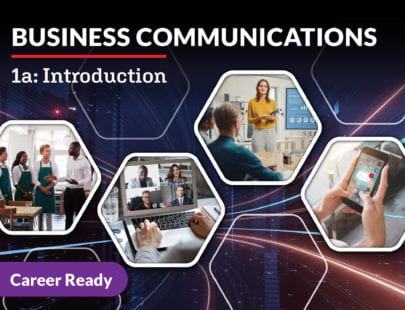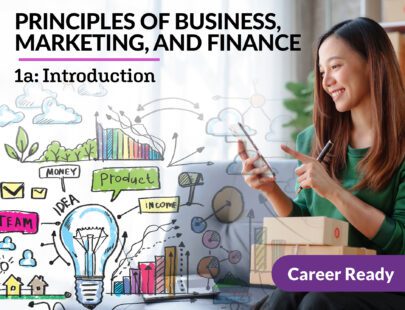
Business Communications 1b: Listen, Speak, & Write in the Workplace
You’ve learned your audience, found your voice, and can read the body’s unspoken words. Now, it’s time to limber up those fingers and learn the P’s and Q’s of communicating in a business setting. In this course, you’re going to take the basic writing skills you’ve developed and revise them so you can take new approaches to planning, building, and distributing documents for a business audience. You’ll continue to explore the essentials of writing while drafting new understandings of business documents, and then you’ll learn to apply your business communication skills to job applications, interviews, and presentations. No matter your career of choice, learning to effectively communicate will help your professionalism grow leaps and bounds. Let’s get writing!
Units at a Glance
Unit 1: Writing in the Business World
Through your school assignments, you’ve already developed a solid base in written communication. Just think of all the different kinds of writing you’ve done. You’ve probably had experience creating such documents as research reports, book reports, lab reports, poster presentations, and essays. Through your extracurricular activities, you may also have created marketing communication products such as flyers, brochures, posters, and social media posts. Now you’ll take your skills to the next level by mastering the art of writing in a business context, where you must orient everything you produce to your audience and your goals. Writing in the business world also requires you to use various communication channels, adapt to emerging technologies, and write as part of a team.
What will you learn in this unit?
- Identify different kinds of business audiences
- Choose the best writing form to suit the communication task
- Recognize different communication channels
- Convey a professional image through your writing style and habits
- Adopt collaborative writing practices that make you a team player
Unit 2: Research Strategies
You might think that the need for research dwindles once you graduate and leave the school library behind. However, research fuels many business activities. Various kinds of research enable businesses to build knowledge in specific areas and make informed decisions. Consequently, research forms the foundation of various kinds of business writing, such as reports, blogs, and business plans. Sharpening your ability to locate relevant information, share it with others, and document it will allow you to contribute to some of the most significant kinds of business communication.
What will you learn in this unit?
- Describe the different kinds of research and sources used in business
- Conduct targeted internet searches for high-quality information
- Express information from research sources in your own words
- Create research sources using a specific citation style, such as that prescribed by the Modern Language Association
Unit 3: Building Blocks of Effective Documents
Because business readers are so pressed for time, workplace documents must present information and ideas as concisely and clearly as possible. Clarity comes not just from the quality of ideas and the way they’re expressed but also from the way the writer arranges their thoughts. An effective business document follows a logical structure—it lays out content in a way that’s easy for readers to navigate and enables them to understand how sections, paragraphs, and sentences relate to each other. When a business document makes recommendations, it does so by presenting a compelling argument backed up by credible evidence.
What will you learn in this unit?
- Distinguish how the structure of business writing compares with the structure of academic writing
- Create a clear key message and document structure
- Use different organizational patterns to suit different purposes and audiences
- Craft a strong logical argument
Unit 4: Mastering the Writing Process
One of the first writing lessons you’ll learn on the job is that writing is an iterative process. It usually involves repeating several steps, sometimes more than once. In the workplace, documents often go through multiple drafts before they’re ready to be distributed to their intended audience. One of the keys to your success, then, will be mastering the different phases of the writing process, some of which happen before you even pick up a pen or sit down at a keyboard. You’ll also need to manage your time to accommodate all the stages of writing, from generating ideas through to final polishing.
What will you learn in this unit?
- Implement prewriting activities to generate ideas and plan your approach to a writing task
- Illustrate satisficing and freewriting to rapidly produce first drafts
- Incorporate visual design into your writing process
- Revise your writing
Unit 5: Crafting Different Business Genres
In school, writing takes a limited number of predictable forms. In an English class, you can expect to write essays and book reports, and in a science class, you’ll likely write lab reports. In the business world, however, the kinds of writing you’ll be called upon to create will include types of documents and messages you may never even have heard of before. To make things even more complicated, the kinds and forms of writing can vary from organization to organization. To succeed as a business writer, you must learn to recognize and reproduce the various forms of writing you encounter, using advanced features of word processing software.
What will you learn in this unit?
- Recognize common forms of workplace writing
- Use and adapt writing templates
- Format documents using word processing software
- Share documents to facilitate tracking and reviewing
Unit 6: Avoiding Grammar Glitches
Many people think of grammar as a collection of “rules,” the dos and don’ts we must obey in order to write correctly. However, an accurate definition is much broader than that. Grammar consists of the customs and principles that shape language use. These aren’t rules so much as conventions—habits of socially acceptable writing that can vary from one generation to another and one culture to another. Mastering these conventions requires learning the functions of different kinds of words and the ways they work together to express ideas.
What will you learn in this unit?
- Describe the range of writing conventions you’ll be expected to follow in the workplace
- Identify the functions of different kinds of words (parts of speech)
- Recognize common grammatical issues that can interfere with clarity
- Edit your writing to avoid grammatical issues
Unit 7: Proper Punctuation and Mechanics
When you talk, you help others understand what you’re saying by inserting pauses and changing the pitch of your voice. When you write, punctuation plays a similar guiding function. Using punctuation marks correctly is part of complying with the mechanics of writing—conventions beyond grammar that ensure your meaning gets understood. Other examples of writing mechanics include spelling, capitalization, quotation marks, apostrophes, and the use of numerals. Understanding and applying the conventions of writing mechanics is essential to clear and polished business communication.
What will you learn in this unit?
- Create four different sentence structures: simple, compound, complex, and compound-complex
- Apply the punctuation conventions of Standard American English
- Use capitalization properly
- Follow conventions of spelling, such as apostrophes, quotation marks, and numbers
Unit 8: Selling Yourself Through Resumes and Cover Letters
Looking for work is a sales job. It requires you to research job opportunities and pitch yourself to potential employers through two specific forms of business writing: resumes and cover letters. In addition, you may also want to compile a portfolio demonstrating your skills, strengths, and experience. This could be as simple as a binder of documents, or it could be an electronic portfolio created as a website or on an online platform. When you take the time to craft job search materials that genuinely reflect who you are and speak to employer needs, your applications attract attention, even when the job market is crowded.
What will you learn in this unit?
- Conduct a job search using various approaches
- Create a professional resume showcasing your skills and experience
- Write a persuasive cover letter tailored to the employer
- Prepare a professional electronic portfolio
Required Materials
Physical
- Video recording device
- Audio recording device
- Camera
- Paper
- Pen
- Markers
Software
- Word processing software
- Spreadsheet software
- Presentation software
- Screen capture recording software
Other
- A person to offer writing feedback
Optional
- Digital design software




